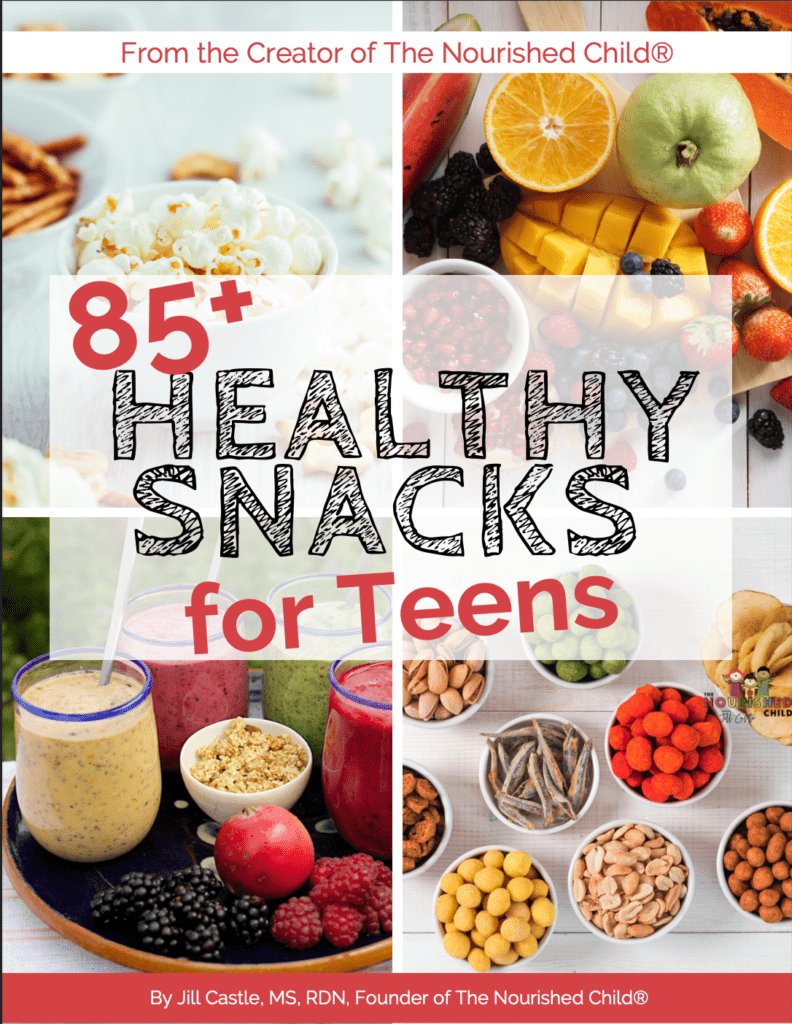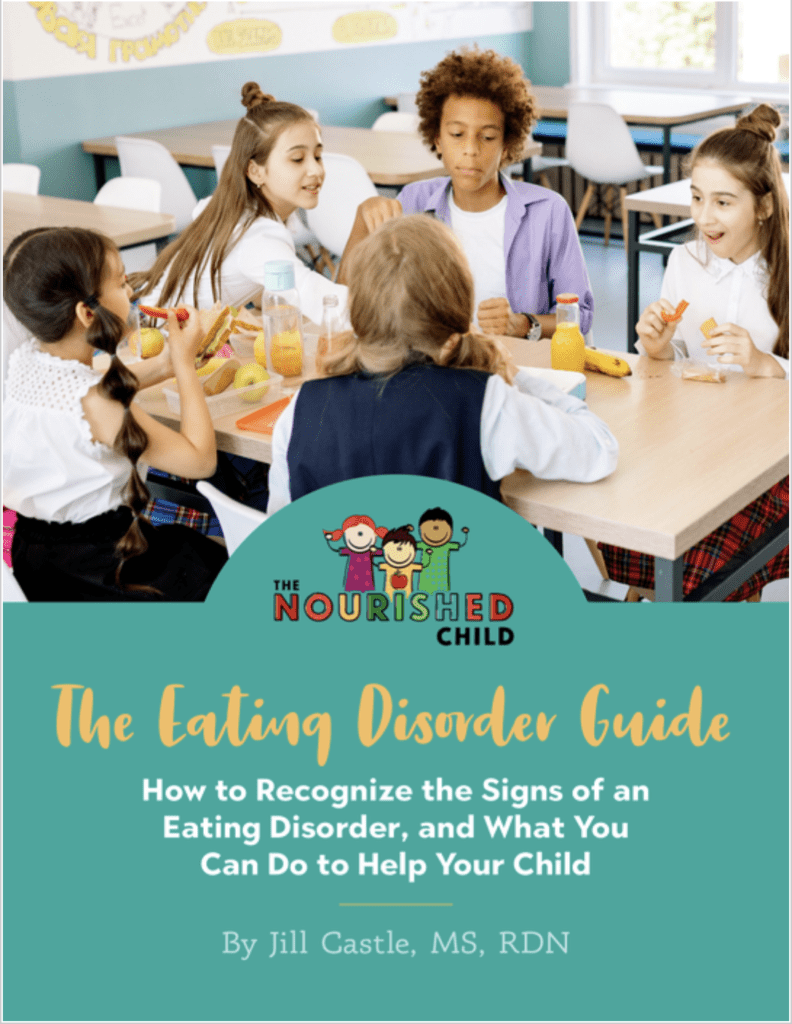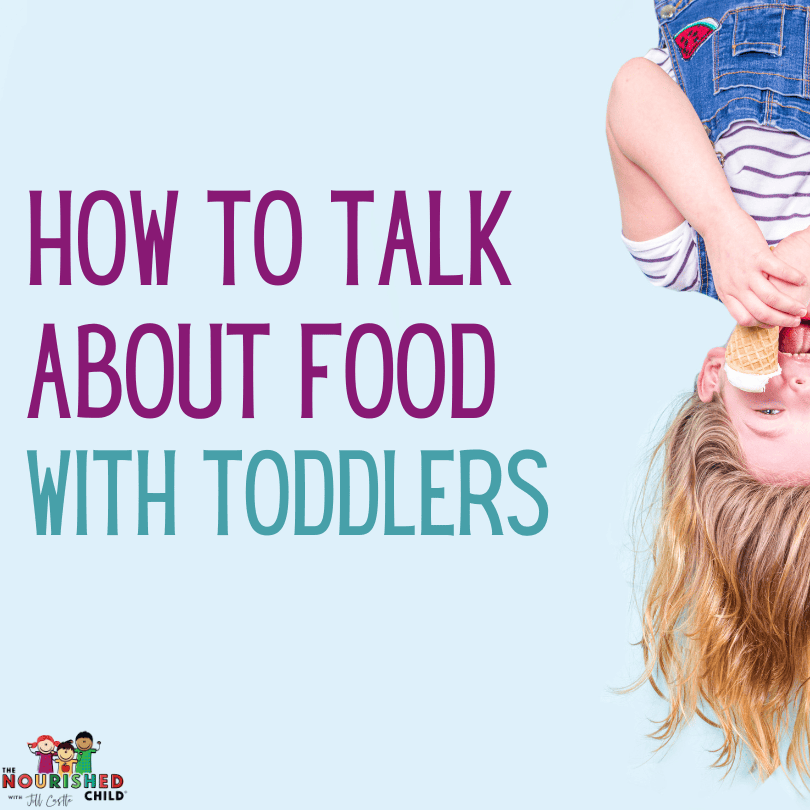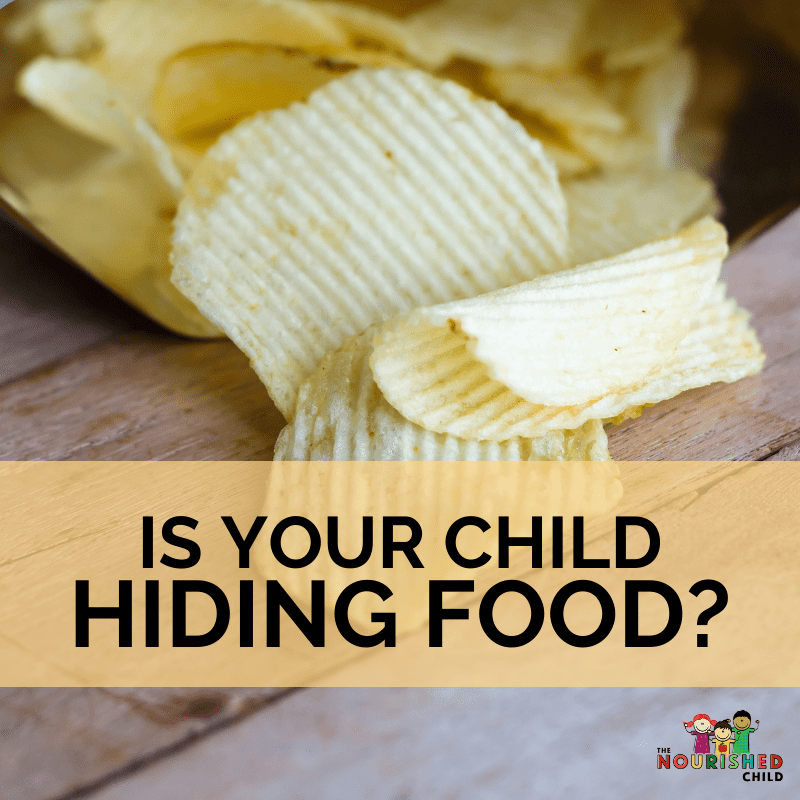Teenager Not Eating Lunch at School? (Here’s Why + Tips)
November 16, 2023
Why is your teenager not eating lunch at school? Learn the common reasons for food disinterest, poor eating and why teen eating can get off track in the high school years.
Last year, we moved to a new town and my teens started a new high school.
Our normal lunch routine changed. Dramatically.
Gone were the cute lunch boxes. The thermos. And the ability to access a microwave.
The willingness to eat yogurt, or take a salad disappeared.
And to make things worse? My teenagers refused to take an insulated lunch box.
Instead, they wanted to buy their lunch, just like their friends. So we tried that approach.
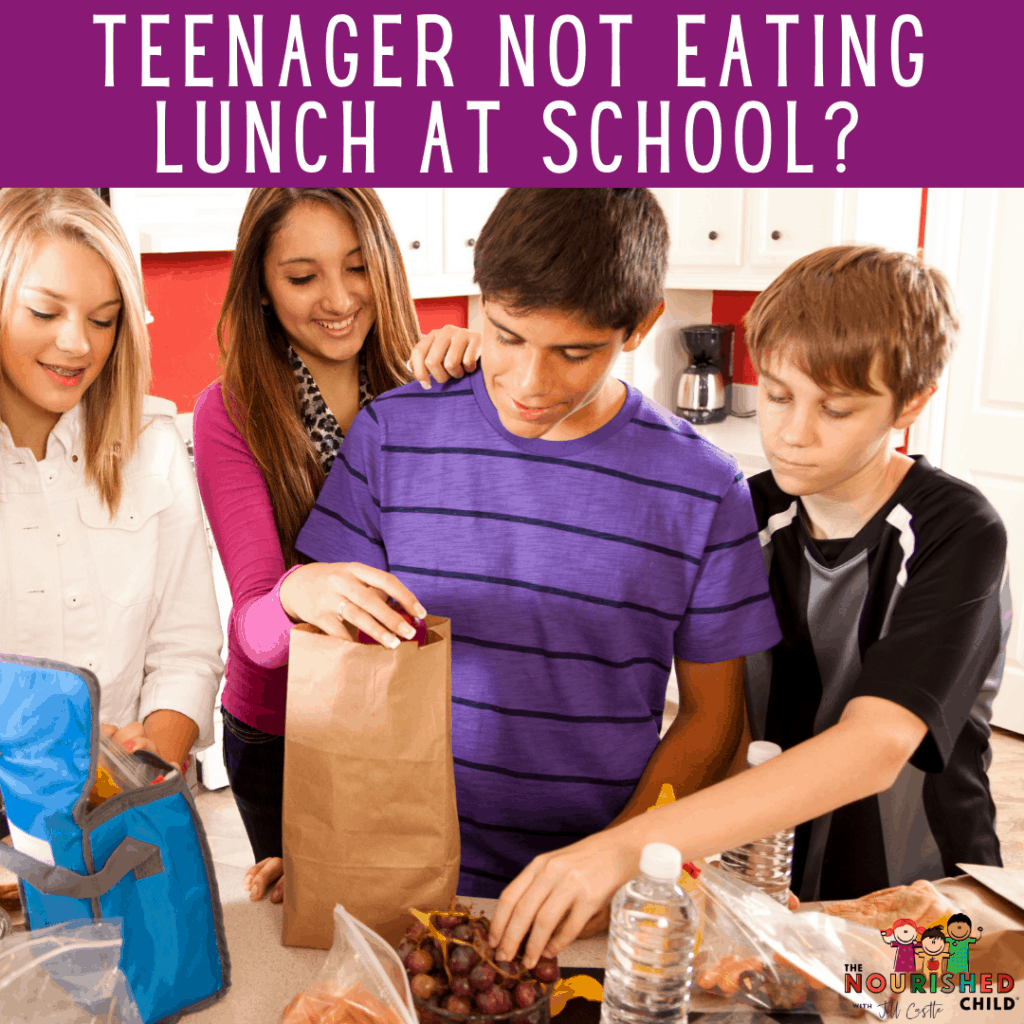
Teens Not Eating Enough in the School Lunchroom
Many of you know, my teenagers played sports in high school.
I had a swimmer, a volleyball player, and a rower.
My swimmer was eating a salad with chicken every day at lunch period, but getting bored and not finishing it. Then she added a gigantic chocolate chip cookie to her lunch tray.
Daily.
For someone preparing for a two-hour swim practice after school, she was under-fueling. In other words, she was not getting enough energy to do the work at swim practice.
It was easy to see why she had a headache, was grumpy, and wiped out after practice.
Nope, this was not working.
[Related Read: Healthy Snacks for Athletes Under 18]
My volleyball player was in the same boat, but forgetting to get a drink, or not having enough time to do so. Her energy levels were dragging at practice and she was dehydrated.
[Related Read: How to Keep Kids Hydrated]
None of this was good for either of them.
So we transitioned back to bringing lunch to school, and I honored all the limiting requests, instead of getting into a power struggle with them.
School Lunches: How It Went
My girls wanted a peanut butter and jelly sandwich. Thankfully, I was a whole wheat bread maker, so they always got some whole grains.
I added a fruit, a veggie, whole grain crackers or chips, and a cheese stick or round to beef up the lunch offerings.
For the most part, they didn’t eat it, complaining that I had packed too much food for them to eat during the lunch hour!
After a month of peanut butter and jelly, they complained about that, too.
Aside from my frustration, I had to step back and put my pediatric nutrition professional hat on.
What was going on here? Of course, it wasn’t just one thing, but a multitude of factors, including my frame of mind.
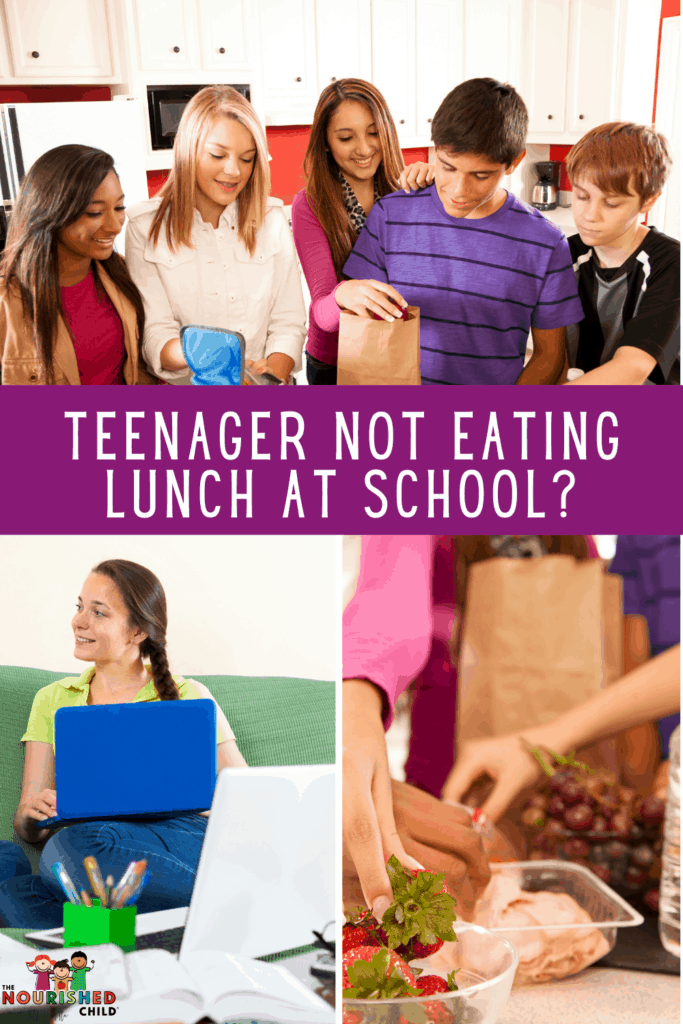
The Reasons Why Teens Cut Down on Eating at Lunch Time
There’s a lot that can be going on here. Let’s take a closer look at why teens may not be eating enough at school.
From pressure to keep up with peers to attempts at weight loss, many reasons exist.
1. Pressure from Peers
Young teens want to be like their friends—wearing the same clothing styles, hairdo, and yes, eating the same foods for lunch.
It’s not until they are older (16 or 17 and up) that they may become more interested in being unique, different, and actually take pride in this.
My girls wanted to buy lunch from the cafeteria, and if they were bringing lunch from home, it needed to be in a brown paper bag.
Bottom Line: My girls didn’t want to be different or stand out from the rest. They wanted to fit in, even in the lunchroom!
2. Socializing with Friends
For high school students, lunch is a social time for connecting with friends, and being seen.
Especially when you’re in class all day, and the classes may not be with your friends. Even if there are short breaks between classes, it’s just not enough social time.
As a result, all the energy goes to socially connecting, and there isn’t much time, or focus, on eating.
I know my girls eat during their study break (a sandwich) and tend to eat their sides at lunchtime in the cafeteria.
They want to eat quickly so they can get down to the business of chatting and socializing.
3. Food Preferences are Changing
Peanut butter and jelly sandwiches didn’t work daily anymore. My teens got bored.
Yet, extravagant foods in multiple, colorful containers weren’t their thing either (believe me, I wish it was!).
We moved to efficiency, taste, eye appeal, and peer-appropriateness as the new lunch packing criteria.
I think you’ll find tastes and food preferences expand to include a variety of foods as your teen’s world opens up. A good thing!
4. Teen Development
Like infants, toddlers, and kids, teens are always changing and there are different reasons for their wants and desires.
I could continue to do things the way I’ve always done them, but the truth is, their changes necessitated me to change too.
If I didn’t, they’d probably adopt some undesirable behavior in response, like tossing out the lunch I packed, eating a friend’s lunch, buying lunch secretly, or worse, not eating at all.
As parents, we always need to keep our eyes on what’s happening with overall development. It certainly has an influence on food choices and eating behaviors.
[Related Read: 5 Bad Food Habits in Teens]
5. Poor Body Image or Body Dissatisfaction
In the teenage years, some teens stop eating because they’re unhappy with the way they look.
In an attempt to lose weight or change their size, some teens will limit their eating or go on a diet.
If you’re concerned about your teen’s eating, please check out my eating disorders series, starting with Part 1: Eating Disorders: The Facts and Stats or my Eating Disorder Guidebook, to understand the variations and what to do if you suspect your child is struggling.
6. Fear of Weight Gain
Related to the above, some teens cut back on eating because they’re afraid of gaining weight, especially if they are “average” in size. This may be the beginning of dieting and perhaps, dysfunctional eating behaviors.
Teens are at higher risk for eating disorders and serious health problems, so be on alert for these eating habits, as they may contribute to more problems later on.
7. Food Insecurity
Many children and teens live in food-insecure homes, where the resources for packing a lunch or buying lunch from school may not be available.
When a teen isn’t eating lunch at school, it may be a clue to food insecurity. Thankfully, there are options for free meals at school.
8. Picky Eating
Yes, there are picky eaters in high school, too. Eating unhealthy foods, an unbalanced meal, or just choosing not to eat may be a sign of serious picky eating.
9. Appetite Loss with Stress
More and more teens are experiencing stress and this can lead to appetite loss, or extra eating to soothe emotions.
What You Can Do if Your Teen’s Not Eating at School
This year, my teens and I sat down and discussed the food guidelines for bringing lunch. Talking together helped us all get on the same page. I encourage you to do this, too, if you’re worried about whether your teen is eating at school.
We decided to return to our once-a-week school lunch purchase policy, and I started packing lunch for the rest of the week again.
Here’s what they wanted:
Sandwiches with lots of veggies (wraps and “different kinds of bread”), fruit, and water.
All in a paper bag.
If my job is to meet my teen’s nutritional needs in a wrap, then I’m up to the challenge! I’m picturing lean deli meats, egg salad, tuna salad, chicken salad, hummus or avocado, and lots of veggies, all wrapped up.
More Tips for Offering Nutritious Meals at School
Remember, variety is the name of the game! It’s the best antidote to boring lunches.
- Vary the protein source, including deli meats, nut butter, hummus, and other bean spreads, hard-boiled egg, cheeses, and Greek yogurt.
- Load sandwiches with veggies and send a healthy portion of fruit or vegetables like baby carrots. This way they can snack on any leftovers throughout the day if they are hungry.
- If your teen will take a protein-topped salad, or leftovers, go for it!
- Invest in some cool water bottles and encourage refilling them at school throughout the day.
- Experiment with different breads: Wraps, hoagies, French, rye, baguette, bagel, etc.
- Send in an after-school snack for sports practices after school. Some ideas I have are nuts and dried fruit; apples and nut butter pack; cheese sticks and crackers; a protein-based granola bar; Gorp; or some other protein/carbohydrate combination.
The most important thing is to work with your teen to come up with healthy lunches, whether they are a packed lunch from home, or bought in the school cafeteria.
The school year is long. It’s important to encourage school meals and nutritious lunch choices so your teen is well-equipped to learn and is able to avoid mood swings and blood sugar shifts.
If you suspect disordered eating or an eating disorder is happening, talk with your family doctor as an important first step.
Need More Help Feeding Your Teen?
Check out my parent nutrition education website, The Nourished Child, where you can find nutrition booklets, workshops and online classes.
Be sure to check out The Eating Disorder Guide – it will help you identify problematic eating behaviors early!
Originally published in August 2013 | Updated in November 2023.

